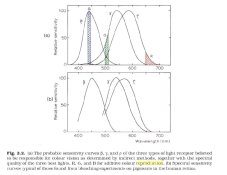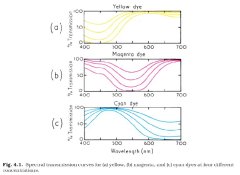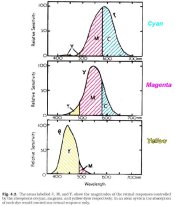holmburgers
Member
In my reading about pigment & dye printing techniques, namely dye-transfer & color-carbon, it is always mentioned and understood that the pigments/inks/dyes that we have available to us are far from theoretically perfect.
Yellow comes the closest to reaching the ideal curve for a subtractive color. Ideally, Cyan should completely transmit green & blue while absorbing all red, Magenta should transmit blue & red and completely absorb green, Yellow should transmit 100% of red & green while absorbing all blue.
In other words, if you looked at a graph of ideal CMY colors, they would be rectangular, encompassing all wavelengths of the colors they should transmit with a sharp cut-off at the point of desired absorption.
This PDF (follow link) shows graphically the ideal and real color response of dyes used in DT; it is analogous to all "process colors" that we use, whether it's pigment, ink or dye. You'll see that the colors we use are far from the ideal.
(there was a url link here which no longer exists)
Now, this information is old, but in 1982 Luis Nadeau says the same exact things about color-carbon pigments. I believe this is still the case today.
So, my question is totally theoretical, but I'm curious how we (as in humans in the 21st century... not you or me necessarily) might be able to achieve the ideal, hard-cutting pigments.
I think the answer lies in nanotechnology. (something that I know very little about.)
Another interesting side note is that these process colors are picked for attributes other than just their color, namely light-fastness & transparency. They are generally acid dyes, but basic dyes are known to have much purer and brighter colors, though they fade quickly. It would be interesting to see a print made with these fugitive dyes, if only for a short period of time. I'm curious about their color curves, and how close they approach the ideal.
But back to nanotechnology. I don't know enough to be helpful, just enough to be dangerous. But nanotechnology seems to be the "hat rack for future development" so I too will hang my hat on it and wait for the nano-messiah. Anyways, it seems that if we can create tiny structures with a high degree of customization and control, perhaps we can attain perfect color curves.
I'd love to hear from someone who might actually know a thing or two about this, but at any rate, it's food for thought.
Yellow comes the closest to reaching the ideal curve for a subtractive color. Ideally, Cyan should completely transmit green & blue while absorbing all red, Magenta should transmit blue & red and completely absorb green, Yellow should transmit 100% of red & green while absorbing all blue.
In other words, if you looked at a graph of ideal CMY colors, they would be rectangular, encompassing all wavelengths of the colors they should transmit with a sharp cut-off at the point of desired absorption.
This PDF (follow link) shows graphically the ideal and real color response of dyes used in DT; it is analogous to all "process colors" that we use, whether it's pigment, ink or dye. You'll see that the colors we use are far from the ideal.
(there was a url link here which no longer exists)
Now, this information is old, but in 1982 Luis Nadeau says the same exact things about color-carbon pigments. I believe this is still the case today.
So, my question is totally theoretical, but I'm curious how we (as in humans in the 21st century... not you or me necessarily) might be able to achieve the ideal, hard-cutting pigments.
I think the answer lies in nanotechnology. (something that I know very little about.)
Another interesting side note is that these process colors are picked for attributes other than just their color, namely light-fastness & transparency. They are generally acid dyes, but basic dyes are known to have much purer and brighter colors, though they fade quickly. It would be interesting to see a print made with these fugitive dyes, if only for a short period of time. I'm curious about their color curves, and how close they approach the ideal.
But back to nanotechnology. I don't know enough to be helpful, just enough to be dangerous. But nanotechnology seems to be the "hat rack for future development" so I too will hang my hat on it and wait for the nano-messiah. Anyways, it seems that if we can create tiny structures with a high degree of customization and control, perhaps we can attain perfect color curves.
I'd love to hear from someone who might actually know a thing or two about this, but at any rate, it's food for thought.










